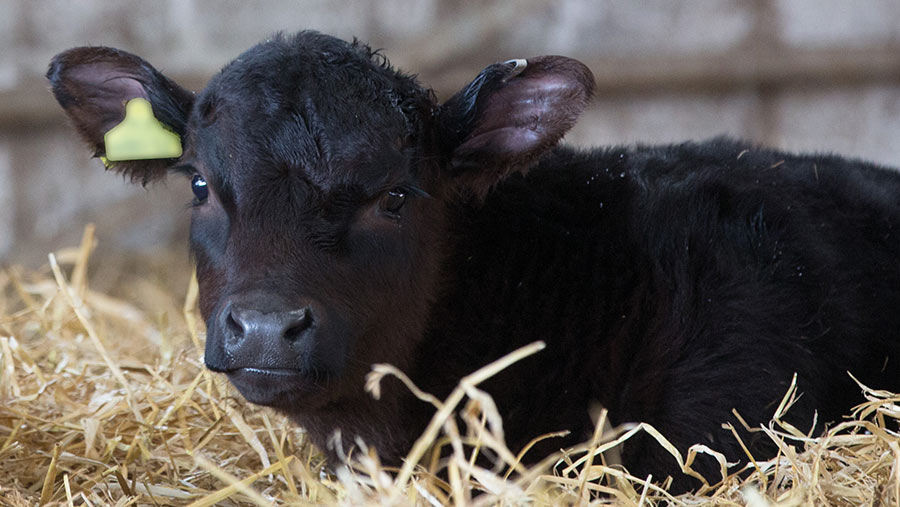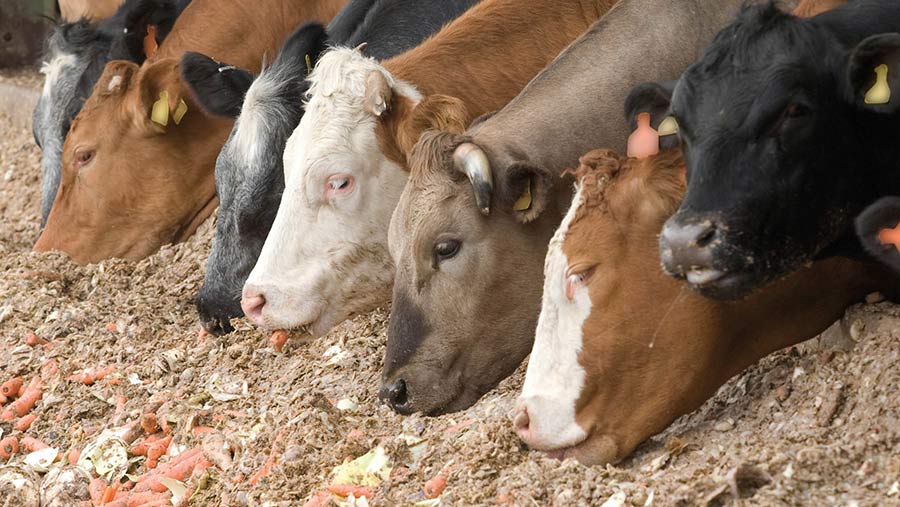How Much Land in Uk Is Used for Beef Cattle
More farmers are considering beef production as the industry experiences a sustained period of buoyant returns.
Buying in calves and selling them as stores is now the most common system in the UK.
But for some, the advantages are greater with suckler beef, and stores-to-finishing can yield a return of 5-7% on capital invested.
John Crimes, of Cara Wales, considers three different systems and their potential.
See also: Boosting dairy and beef rations with bioethanol by-products
Suckler beef
Infrastructure
Unless calving is going to be outdoors, suitable indoor facilities are needed, and plenty of them, as ideally the calving block should be tight.
Loose housing is most common, but an increasing number of ex-dairy farms house in cubicles.
Cattle generally keep cleaner in cubicles, but loose housing is better suited to nitrate vulnerable zones (NVZ) because it doesn't require dedicated slurry storage.
Very little machinery is needed – this system can work with a straw chopper and a skid-steer for scraping out and feeding.
Market opportunities
Suckler-bred animals can be sold as weaned calves, stores or finished.
Weaned calves are generally best sold through livestock markets known for good-quality suckled calves.
Store cattle can be sold through markets or privately to finishing units. They can also be marketed using web-based services, advertising or dealers.
Finished cattle are best sold direct to an abattoir, targeted to specific outlets.
Location and land base
Suckler cattle are highly suited to marginal land.
Even the best-performing upland cattle and sheep farms are stocked at only 1.27 livestock units a hectare (lu/ha). But a rate of 2lu/ha or higher is possible by using an efficient, small breed of cow or by reducing size within a breed, and rotationally grazing stock.
Labour
Work is condensed into the calving and breeding periods along with management at weaning.
Capital requirement
About £1,000 a cow place for a greenfield site, or £600 for loose housing.
Return on capital
Average margin before rent and finance on an upland suckler cow is £350, or £540 with subsidy factored in, according to the most recent Wales Farm Business Survey.
Average profit/ha on an upland suckler and sheep farm, after subsidies, is £180, so without subsidies an average system wouldn't make money.
However, the top third is making a 4% return on capital by focusing on timing of cattle sales and stock quality.
Cara Wales customers are making a profit on low-cost systems by using good genetics.
For example, an organic farm with 50-60 suckler cows selling finished offspring to the organic market is making £50,000 a year including subsidies, or £30,000 without subsidies.
Pros and cons – suckler beef
Pros
- Value of the progeny, whether they are sold as stores or finished, is generally always higher than dairy-bred cattle – at today's prices £150-£200 higher.
- Annual output and income are relatively predictable
- A secondary income stream can be generated from sales of breeding stock
- Running a closed herd means no health issues are imported
- A farm can use poorer land for sucklers because they have low maintenance requirements
Cons
- Safety risks around calving
- Not quite as profitable as a calf-to-store system
- Resources are not fully utilised because for part of the year there is only one animal for every two livestock places
Buying in calves and selling as stores

© Tim Scrivener
Infrastructure
An isolation facility is needed for incoming stock, together with dedicated calf-rearing facilities such as a polytunnel, a purpose-built calf shed or hutches.
These need a hot and cold water supply, good lighting and ventilation, and must be easy to clean and disinfect.
Loose housing is needed for rearing the cattle as they get older, although some producers favour cubicles. Ideally, the system should be "all in, all out" for high biosecurity.
Market opportunities
Sales can be made through live auctions, internet-based portals such as Sell My Livestock, or Breedr, an app which links up farmers buying and selling specific cattle.
Another route is to sell 15- to 18-month-old stores privately to bigger finishing units.
Purchases are often made on the basis of weighing the empty livestock trailer, deducting this from the weight of the full load and paying a pre-agreed price a kilogram.
This suits those who don't fancy the market and helps de-risk, because the price is agreed in advance.
Location and land base
This varies with the type of cattle and the target market. For example, Holstein calves crossed with a continental won't suit a hill farm on marginal land, but breeds like a Hereford-cross, a Stabiliser-cross or a Shorthorn will.
A lowland farm with improved grass is ideal for a finishing unit. The alternative is a shed-based intensive system.
Labour
Calf rearing is one of the hardest skills to hire in, and the system is more labour-intensive than other beef systems
But the work is more evenly spread throughout the year, which can be attractive to potential employees.
Capital requirement
Budget £700-£800 an animal place.
Return on capital
Potentially, 15-18% of output can be retained as profit. For example, if a store is sold for £1,200, the profit can be £250-£300 a head.
Pros and cons – buying in calves
Pros
- Timing of purchase and sales is controlled by the farmer
- Every livestock place is a productive animal that can be sold
- Potential to improve the quality of incoming stock as some agreements allow farmers to have an input into the sires used
- Slightly more profitable than sucklers
- Buying privately from two or three known suppliers can help prevent disease
Cons
- Every calf bought in has the potential to bring disease onto the farm
- Maintaining consistent inflow and outflow can be a challenge
- Average calf price can rise by £50 a head during periods of price volatility
- Sourcing skilled labour for calf rearing can be difficult
- Dairy-bred calves may fetch lower prices than suckler-bred progeny
- Cattle sold may have to stay on farm longer than needed, as some abattoirs have a lead-in time of several weeks. This can be expensive for big batches
Buying in stores and finishing
Infrastructure

© Tim Scrivener
Cattle are big and strong and facilities must match this – loose housing is ideal.
Size of cattle will also affect stocking density.
Market opportunities
Cattle are mostly sold direct to slaughter, often through an established agreement with an abattoir, so nurture a close relationship.
Most producers target a specific market – some buyers pay well for weight and grade, while others favour dairy crosses.
The key is to know which market to aim for and to be aware of deadweight limits.
Location and land base
Cattle lose weight in transit so the shorter the trip to the end buyer, the better the return.
Bear in mind Defra's consultation on the live transport of livestock – it is likely to limit mileage to an abattoir, not increase it.
This system is well suited to a farm that can produce quality wholecrop, grass silage or maize. Access to by-products and cheap feeds is another important consideration.
Labour
With good handling facilities and mechanised feeding and bedding, labour requirement can be low – one person can look after 250 animals or more.
Capital requirement
Budget £500 a head.
Return on capital
To get a return of 5-7% the cattle need to be finished quickly and cheaply.
Pros and cons – buying in stores
Pros
- Stores will have passed the period of highest risk to their health
- Feed type and rate can be adjusted quickly according to market requirements
- Ability to capitalise on cheap feeds when available
- Potential for higher prices if the slaughterhouse can be guaranteed numbers
Cons
- Fine margins between store and finishing prices
- A finisher needs to be at the market regularly to get the best value for money, but it is a numbers game so being choosy is not always possible
- Consistency of stores can be difficult unless the farmer is aligned to a big producer
- Consistency can complicate feeding – a British Blue out of a Holstein will require a different finishing diet to a Hereford out of a Jersey
Source: https://www.fwi.co.uk/livestock/beef/3-beef-systems-and-their-earning-potential-compared
0 Response to "How Much Land in Uk Is Used for Beef Cattle"
Post a Comment